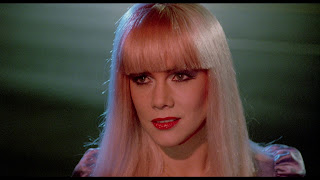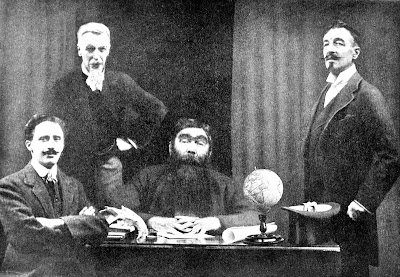Robert Siodmak's
THE GREAT SINNER begins inauspiciously with a writer (played by Gregory Peck), traveling alone, aboard a train bound for Paris. Before the train departs, his lonely compartment is joined by a dour, older woman who is followed aboard by a very beautiful, younger woman (Ava Gardner) who spends the entire trip playing Solitaire and not speaking a word. When the train reaches her destination of Wiesbaden, she and the man stand together and she breaks their long silence, asking if this is his destination too. When he explains that he is bound for Paris, she offers, "What a shame!" and departs - in a manner that suggests great adventure were he to stay. On the spur of the moment, he changes his mind and the entire future course of his life.
As this woman, Pauline Ostrovsky, later explains to the writer Fedya, she felt mystically bound to him throughout their silent shared journey because, for the first time in her life of playing cards, with him at her side, the right cards suddenly began falling invariably into place. She has gone to Wiesbaden to join her father General Ostrovsky (Walter Huston), who, like her, is addicted to gambling - a weakness that Fedya finds so morally reprehensible that he decides to reject the woman, while remaining in Wiesbaden to write a new book about the psychology of such lost souls. Despite his resolve, weakness begets weakness and Fedya soon enough falls in love with Pauline. When he discovers that the Ostrovskys have in effect sold themselves into eternal bondage to casino manager Armand de Glasse (Melvyn Douglas), in the form of two promissary notes amounting to some $200,000 and Pauline's hand in arranged marriage, Fedya determines to free them both by staking his own fortune on the gaming tables. It would not ruin the story to reveal that - in a thrilling sequence - he is both highly successful in his dare, and ruinously contaminated by his success.
 |
| Ava Gardner and Gregory Peck with director Robert Siodmak. |
This film - produced by MGM as part of the studio's "Silver Anniversary" - was loosely based on Fyodor Dostoevsky's story "The Gambler," to which it bears only modest resemblance. Its screenwriters were an interesting pair: Ladislas Fodor (who, remarkably, wrote James Whale's
THE KISS BEFORE THE MIRROR and George Pal's
TOM THUMB before going on to write several Edgar Wallace
krimis and Karl May westerns, as well as Jess Franco's
THE DEVIL CAME FROM AKASAVA!) and noted author Christopher Isherwood (whose BERLIN STORIES were the basis of CABARET and whose other scripts include
THE LOVED ONE and
FRANKENSTEIN: THE TRUE STORY). There have been a number of films about the dangerous allure of games of chance, and Dostoevsky's story also inspired James Toback's remarkable
THE GAMBLER (1973) with James Caan, but for some reason THE GREAT SINNER's important place in this history tends to be overlooked. It was a box office disappointment in its time, perhaps partly due to the drab reception given it by critics like Bosley Crowther of THE NEW YORK TIMES ("a dreary picture"), but revisitation proves that - like any other Siodmak picture you might care to pull down off the shelf - it still has a great deal to offer.
 |
| Peck puts his entire life on the line to win his beloved's freedom from casino baron Melvyn Douglas. |
The film's production values (including art direction by Cedric Gibbons) are impeccable, but the cast is truly flawless all down the line. Gregory Peck has never been a particular favorite of mine, but this film ranks high (near, say,
TO KILL A MOCKINGBIRD) among his most captivating performances. Ava Gardner is not only stunning but transcends initial expectations by playing a character who, through love, changes places with our lead protagonist and summons unsuspected depths of humanity. Melvyn Douglas inhabits his role with calm authority, so amiable in his wealth and privilege that the extent of his monstrousness comes as something of a shock when it's ultimately revealed. The principal supporting players - Walter Huston, Ethel Barrymore, Frank Morgan and Agnes Moorehead - give remarkable, vivid performances that rank with their very best work. Of these four, it would be wrong to pick out any one over the other, but Frank Morgan's character is particularly well written, and his final scene is unforgettably eerie. It finds him unexpectedly seated next to Fedya when he's in a suicidal state of mind, and Siodmak and cameraman George Folsey stage the scene with the brilliant technical stroke of having Morgan isolated within the frame by camera diffusion - which not only emphasizes Peck's extreme state of alienation from other living people but the fact that Morgan's character has already taken his own life in similar alienation and despair.
 |
| Frank Morgan and Gregory Peck in the film's eeriest sequence. |
Director Robert Siodmak - the brother of screenwriter Curt Siodmak (1941's THE WOLF MAN) - is largely remembered nowadays as one of the great
film noir specialists, on the strength of such films as
PHANTOM LADY (1944),
THE KILLERS (1946) and
CRISS CROSS (1949). However, he was just as importantly a major - and somewhat overlooked - director of horror, as can be seen in his expert handling of Universal's
SON OF DRACULA (1943), the astonishingly subversive serial killer thriller
CHRISTMAS HOLIDAY (1944), and the "Old Dark House" chiller
THE SPIRAL STAIRCASE (1945). Though a mainstream production in every sense of the term, THE GREAT SINNER plunges into areas of human experience so dark as to intermittently qualify as borderline horror. This becomes particularly clear during a later scene in which Fedya -
deranged by hunger and a need for gambling money - revisits a pawn shop run by a wen-eyed
crone played by Agnes Moorehead. Strictly through the use of
jarring editing and unexpected imagery, Siodmak forces us to share Fedya's
increasingly murderous state of mind, creating one of the most alarming
1940s terror sequences I've seen, and the film's one true debt to the moods cast by Dostoevsky himself in his writings. But the film achieves its real apogee of horror in a moment when the viewer, too, suddenly is made to feel infected by the secret geometries cast by numbers, as they stand alone or in combination, which compel people to bet everything on the red before consigning their souls to eternal black.
If you've never seen THE GREAT SINNER, what are you waiting for?
It's a
good bet.














































